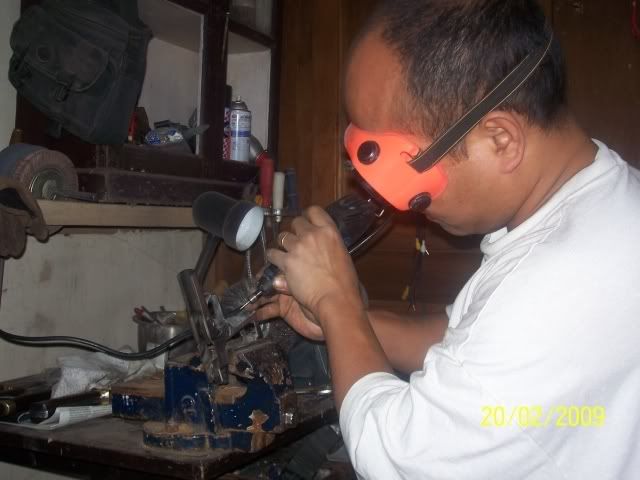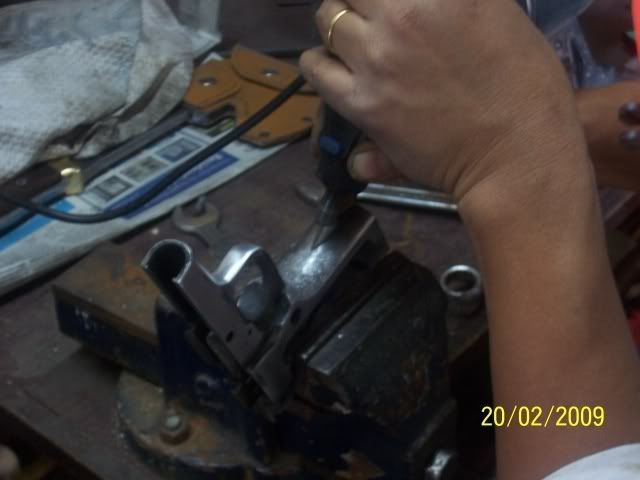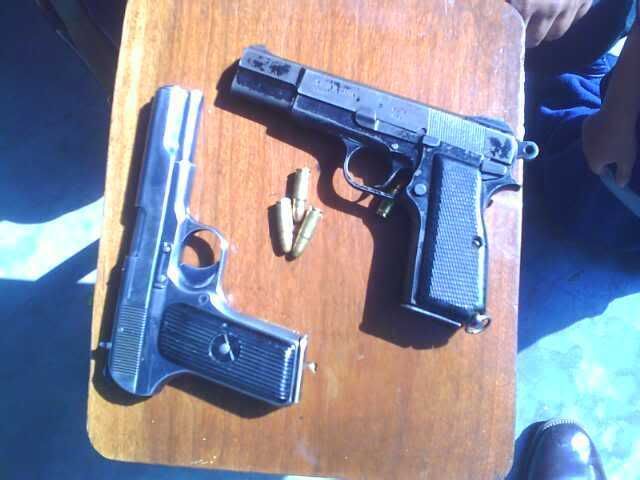Stippling
Posted: Wed Jul 23, 2008 3:02 pm
http://www.hamcontact.com/airgun/Stippling.htm
A small tutorial for those interested
I have seen a lot of post over time asking about stippling. Now this is not a "holy grail" of Stippling or even close, but hopefully it will help those who have considered trying it but just didn't feel they could do it, or just needed a few guidelines to give them the confidence to try it.
First, you should play around a bit with some scrap wood to get a feel for it. But when you do, try and get a small piece of low quality Walnut so that what you learn will be close to the results and the "feel" of the same wood as what you will actually be doing it on. For example a soft open piece of Pine will not react the same way as a good tight grained piece of Walnut.
Now this is how I go about it, and others may have the same results or better using a different method, and or tools but this is what works for me.
The tool I use is a RotoZip with flex shaft, and small diamond burrs. A small set is shown below. I run the tool at 15,000 rpm, it is a variable and this is the slowest speed, if you increase the speed too much you wind up burning the wood. Of course any good rotary tool will work, such as the Dremel, or the Black and Decker rotary tool.
There are several reasons for my use of the diamond burr over a Carbide burr. First unlike a carbide burr which must have cutting teeth to work, the diamond burr is in my opinion much more controllable. It also by it's nature an abrasive, so in addition to creating the pattern, it in effect "sands" the pattern as you go. The benefit of this in my opinion is that one it does not pull up or separate the grain as a cutter bit would and it also will make the grain show through when finishing with oil.
You really don't have to spend a bunch on these, and they are available at the discount tool stores like Cummings, or Harbor Freight. Now if I were to being doing a lot of metal work I would probably opt for a high quality set, but for woodworking even the "bargain" sets will do the job nicely.
For creating the outline I use the last tool in the set at position #20. It will create a groove, either straight or curved around the parameter of the area you are going to stipple. You must have a steady hand and go slow and careful. One of the reasons for the use of the flex shaft is to allow doing the more difficult areas with out danger of the larger head of the main tool from touching the wood and marring it. I freehand the lines onto the wood, but if you would feel more comfortable with it, a pattern pre made and wrapped onto the wood and traced would work as well. It is an extra step that I don't do, and if you put your original lines down light, and get it wrong it is an easy task to simply erase it and redraw.
This next picture is an almost completed section where your thumb will lay while shooting, the only thing left to do is straighten and clean up the edge lines a little more. Three sizes of the ball burr were used to get into the progressively smaller point of this area.
Below is the opposite side, showing the progression of the main area stippling. As you can see Stippling is really a random pattern, so I guess the best way to describe doing it is to just lightly plunge the tool helter skelter until you have most of the original surface gone.
As you progress with the Stippling you simply place the tool in areas that need a little more attention. Stippling is very forgiving in the main areas, and as you practice on a throw away piece you will quickly learn your own method of getting the random yet even look. The real finesse comes into play at the borders, here you must be very careful.
There are tons of methods for holding/clamping something, but for Stippling I like a lot of tactile feedback so I sit cross-legged on the floor with the piece laying on my lap and with both elbows on my knees, and firmly grasp the tool with both hands with the edges of my palms on the work piece, to me this gives the best control of the tool, to as best as possible prevent skipping and skittering. It also allows me to turn the piece easily and quickly.
As you can see I chose to "freehand" the Stippling at the bottom of the grip close to the Ebony first and do the outline last, this is a bit of an experiment, but I think that it may result in a cleaner line, and keep the Stippling with a more even appearance close to the outline....I will soon find out.
So get yourself some scrap Walnut and give it a whirl, it is for the most part not all that difficult, and the feel of the stock with the added grip is worth the effort in addition to giving that ho hum stock a bit of a custom look.
A couple hours more of poking and prodding......a little further along. Daylight was going down so it will wait until tomorrow. Here is both sides more complete, total time thus far is about 4 hours. A little cleaning up/evenening up and the borders and it will be finished.
Well it's another day, and on to the borders. The borders were done with the last tool on the right side of the set shown above. The small radius of the tool allows for both straight and curved borders. This is where you must be very careful, one little slip and things can go wrong quickly. The shank of the tool will aid you in keeping the depth about where it should be. "Burying the tool head" may be a bit deeper than you want so go slow to keep the outline depth where you want it. Or if you want and you are careful with your ball tool it is not absolutely required to put a border on the stippled areas, as you can see from the picture above, but I feel that it dresses it up to do so.
The stock along with the borders and Stippling now has two coats of Tung oil. It was oiled after the bordering to help show how the grain will come through the Stippling as you finish. In most cases you will only apply 2-4 coats of oil in the Stippling and many more coats on the main areas of the stock. The application of Stippling is to aid in the gripping properties of the stock; and applying too many coats of oil will in my opinion make it slicker than desired.
When applying additional coats of oil to the main areas of the stock, care must be taken to keep the oil from bleeding into the stippled areas. If you should get oil bleeding into the stippled areas and it causes areas to become too glossy and irregular this can be corrected by dampening a soft rag with mineral spirits and carefully rubbing these border areas, the mineral spirits will break the gloss and bring the stippled area back to a uniform look.
I hope you enjoyed my bit of rambling....
Written by Marty MacNaughton of Silver Streak Sports
A small tutorial for those interested
I have seen a lot of post over time asking about stippling. Now this is not a "holy grail" of Stippling or even close, but hopefully it will help those who have considered trying it but just didn't feel they could do it, or just needed a few guidelines to give them the confidence to try it.
First, you should play around a bit with some scrap wood to get a feel for it. But when you do, try and get a small piece of low quality Walnut so that what you learn will be close to the results and the "feel" of the same wood as what you will actually be doing it on. For example a soft open piece of Pine will not react the same way as a good tight grained piece of Walnut.
Now this is how I go about it, and others may have the same results or better using a different method, and or tools but this is what works for me.
The tool I use is a RotoZip with flex shaft, and small diamond burrs. A small set is shown below. I run the tool at 15,000 rpm, it is a variable and this is the slowest speed, if you increase the speed too much you wind up burning the wood. Of course any good rotary tool will work, such as the Dremel, or the Black and Decker rotary tool.
There are several reasons for my use of the diamond burr over a Carbide burr. First unlike a carbide burr which must have cutting teeth to work, the diamond burr is in my opinion much more controllable. It also by it's nature an abrasive, so in addition to creating the pattern, it in effect "sands" the pattern as you go. The benefit of this in my opinion is that one it does not pull up or separate the grain as a cutter bit would and it also will make the grain show through when finishing with oil.
You really don't have to spend a bunch on these, and they are available at the discount tool stores like Cummings, or Harbor Freight. Now if I were to being doing a lot of metal work I would probably opt for a high quality set, but for woodworking even the "bargain" sets will do the job nicely.
For creating the outline I use the last tool in the set at position #20. It will create a groove, either straight or curved around the parameter of the area you are going to stipple. You must have a steady hand and go slow and careful. One of the reasons for the use of the flex shaft is to allow doing the more difficult areas with out danger of the larger head of the main tool from touching the wood and marring it. I freehand the lines onto the wood, but if you would feel more comfortable with it, a pattern pre made and wrapped onto the wood and traced would work as well. It is an extra step that I don't do, and if you put your original lines down light, and get it wrong it is an easy task to simply erase it and redraw.
This next picture is an almost completed section where your thumb will lay while shooting, the only thing left to do is straighten and clean up the edge lines a little more. Three sizes of the ball burr were used to get into the progressively smaller point of this area.
Below is the opposite side, showing the progression of the main area stippling. As you can see Stippling is really a random pattern, so I guess the best way to describe doing it is to just lightly plunge the tool helter skelter until you have most of the original surface gone.
As you progress with the Stippling you simply place the tool in areas that need a little more attention. Stippling is very forgiving in the main areas, and as you practice on a throw away piece you will quickly learn your own method of getting the random yet even look. The real finesse comes into play at the borders, here you must be very careful.
There are tons of methods for holding/clamping something, but for Stippling I like a lot of tactile feedback so I sit cross-legged on the floor with the piece laying on my lap and with both elbows on my knees, and firmly grasp the tool with both hands with the edges of my palms on the work piece, to me this gives the best control of the tool, to as best as possible prevent skipping and skittering. It also allows me to turn the piece easily and quickly.
As you can see I chose to "freehand" the Stippling at the bottom of the grip close to the Ebony first and do the outline last, this is a bit of an experiment, but I think that it may result in a cleaner line, and keep the Stippling with a more even appearance close to the outline....I will soon find out.
So get yourself some scrap Walnut and give it a whirl, it is for the most part not all that difficult, and the feel of the stock with the added grip is worth the effort in addition to giving that ho hum stock a bit of a custom look.
A couple hours more of poking and prodding......a little further along. Daylight was going down so it will wait until tomorrow. Here is both sides more complete, total time thus far is about 4 hours. A little cleaning up/evenening up and the borders and it will be finished.
Well it's another day, and on to the borders. The borders were done with the last tool on the right side of the set shown above. The small radius of the tool allows for both straight and curved borders. This is where you must be very careful, one little slip and things can go wrong quickly. The shank of the tool will aid you in keeping the depth about where it should be. "Burying the tool head" may be a bit deeper than you want so go slow to keep the outline depth where you want it. Or if you want and you are careful with your ball tool it is not absolutely required to put a border on the stippled areas, as you can see from the picture above, but I feel that it dresses it up to do so.
The stock along with the borders and Stippling now has two coats of Tung oil. It was oiled after the bordering to help show how the grain will come through the Stippling as you finish. In most cases you will only apply 2-4 coats of oil in the Stippling and many more coats on the main areas of the stock. The application of Stippling is to aid in the gripping properties of the stock; and applying too many coats of oil will in my opinion make it slicker than desired.
When applying additional coats of oil to the main areas of the stock, care must be taken to keep the oil from bleeding into the stippled areas. If you should get oil bleeding into the stippled areas and it causes areas to become too glossy and irregular this can be corrected by dampening a soft rag with mineral spirits and carefully rubbing these border areas, the mineral spirits will break the gloss and bring the stippled area back to a uniform look.
I hope you enjoyed my bit of rambling....
Written by Marty MacNaughton of Silver Streak Sports




